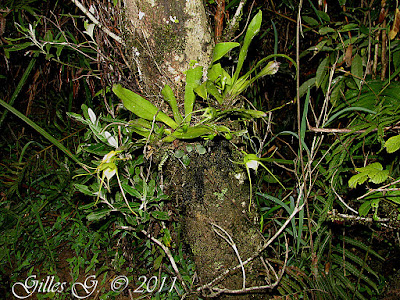Aeranthes caudata is found in the Comoros and central and eastern Madagascar. It grow in deep shade in humid, evergreen forest. They are found on trunks and branches of trees that often are covered with mosses and leafy liverworts at 700-1500 m.
Aeranthes caudata also called as The Tailed Aeranthes, Aeranthes imerinensis, is a species of the genus Aeranthes. This species was described by Robert Allen Rolfe in 1901.
IDENTIFY AERANTHES CAUDATA ORCHID PLANT
Aeranthes caudata is found in the Comoros and central and eastern Madagascar. It grow in deep shade in humid, evergreen forest. They are found on trunks and branches of trees that often are covered with mosses and leafy liverworts at 700-1500 m.
It is a small to medium sized, hot to warm growing epiphyte with an erect, 15 cm long, woody stem carrying ligulate, somewhat undulate leaves.
The Tailed Aeranthes blooms in the summer and fall on a thread-like, 100 cm long, successively single flowered inflorescence with 3 to 8, successively opening flowers. Aeranthes caudata and Aeranthes grandiflora are very difficult to differentiate on the basis of growth habit. However, the inflorescence of Aeranthes grandiflora is well covered with bracts, whereas that of Aeranthes caudata is only about half-covered between each node on the peduncle.
AERANTHES CAUDATA ORCHID PLANT CARE AND CULTURE
Cultural information should only be used as a guide, and should be to be adapted to suit you. Your physical location; where you grow your plants, how much time you have to devote to their care, and many other factors, will need to be taken into account. Only then can you decide on the cultural methods that best suit you and your plants.
Light:
Aeranthes caudata needs a light level of 8000-18000 lux. Conditions should be shaded with filtered, diffused light. Plants should never be exposed to direct midday sun. Strong air movement should be provided at all times.
Temperature:
Summer days temperature at average 26-27°C, and nights temperature at average 16°C, with a diurnal range of 10-11°C.
Humidity:
The Tailed Aeranthes need the humidity of 75-80% most of the year, dropping to near 65% for a short time in spring.
Substrate, growing media and repotting:
Aeranthes caudata may be grown in shallow, well-drained containers or mounted on tree-fern slabs. Mounted plants need high humidity, however, and during hot, dry weather they may need several waterings a day.
If it is difficult to keep mounted plants moist enough, they may be grown in a shallow pot or basket filled with a very open, fast-draining medium that has excellent drainage, is well aerated, and allows the medium to dry fairly rapidly after watering. You can use medium-sized fir bark, but including charcoal in the mix also holds the medium open and prevents souring in the pot.
Plants should be repotted immediately if the medium starts to break down as they are very prone to rot if conditions at the roots become stale. Repotting should be done just as new roots start to grow. This enables the plant to become reestablished in the shortest possible time.
Watering:
Rainfall is very heavy from late spring to early autumn. Amounts then decrease fairly rapidly at the beginning of the 5-month dry season that lasts from late autumn to early spring. Cultivated plants should be watered heavily while actively growing. Water should be reduced after new growth is completed in autumn.
Fertilizer:
1/4-1/2 recommended strength, applied weekly when plants are actively growing. You can use a balanced fertilizer all year. You can also use a high-nitrogen fertilizer from spring to midsummer and then switch to a high-phosphate formula in late summer and autumn.
Rest period:
Winter days temperature at average 20-21°C, and nights average 9-10°C, with a diurnal range of 11-12°C. Aeranthes caudata need less water in winter, but they should not dry out completely or stay dry for long periods. Fairly regular early-morning misting between infrequently light waterings should provide sufficient moisture in most growing areas. Fertilizer should be reduced or eliminated until new growth starts and heavier watering is resumed in spring.















COMMENTS